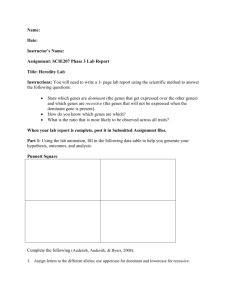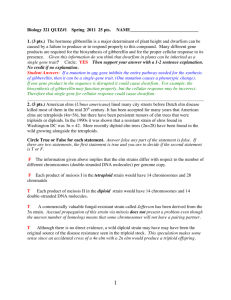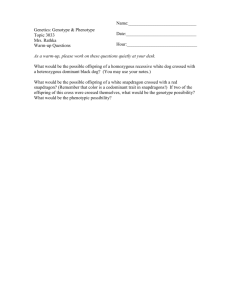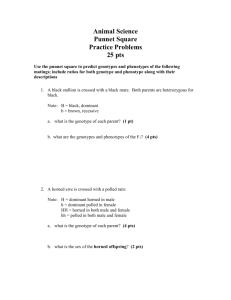Worksheet 4
advertisement
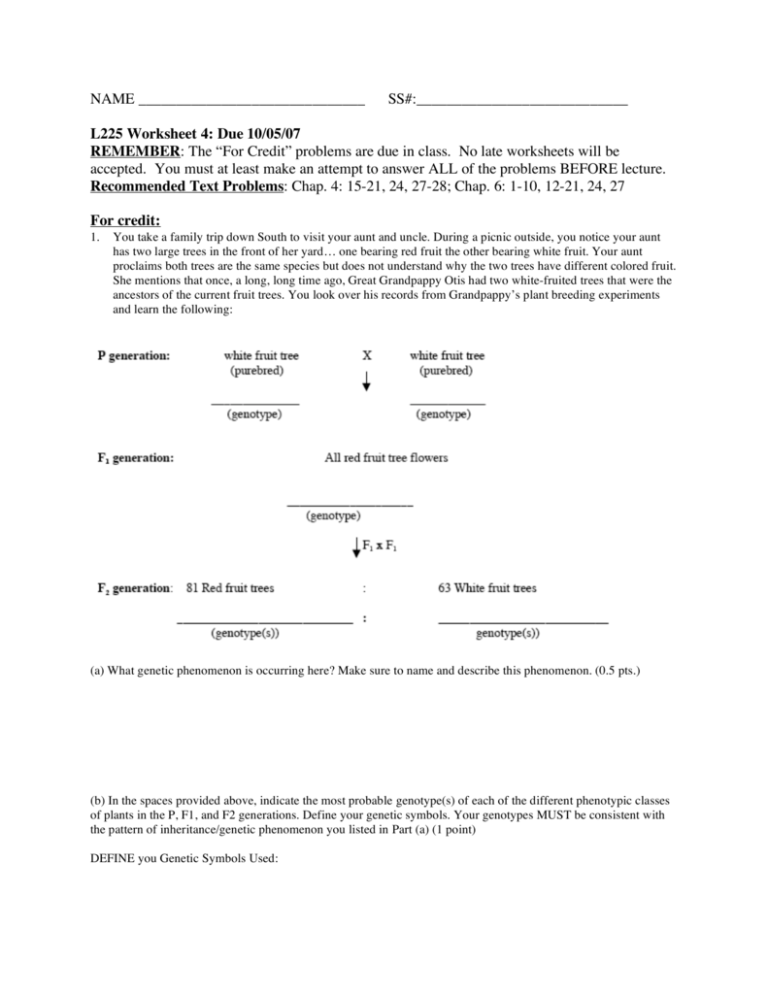
NAME ______________________________ SS#:____________________________ L225 Worksheet 4: Due 10/05/07 REMEMBER: The “For Credit” problems are due in class. No late worksheets will be accepted. You must at least make an attempt to answer ALL of the problems BEFORE lecture. Recommended Text Problems: Chap. 4: 15-21, 24, 27-28; Chap. 6: 1-10, 12-21, 24, 27 For credit: 1. You take a family trip down South to visit your aunt and uncle. During a picnic outside, you notice your aunt has two large trees in the front of her yard… one bearing red fruit the other bearing white fruit. Your aunt proclaims both trees are the same species but does not understand why the two trees have different colored fruit. She mentions that once, a long, long time ago, Great Grandpappy Otis had two white-fruited trees that were the ancestors of the current fruit trees. You look over his records from Grandpappy’s plant breeding experiments and learn the following: (a) What genetic phenomenon is occurring here? Make sure to name and describe this phenomenon. (0.5 pts.) (b) In the spaces provided above, indicate the most probable genotype(s) of each of the different phenotypic classes of plants in the P, F1, and F2 generations. Define your genetic symbols. Your genotypes MUST be consistent with the pattern of inheritance/genetic phenomenon you listed in Part (a) (1 point) DEFINE you Genetic Symbols Used: 2. A new variety of tulip has been discovered in Europe. This tulip is unique because it has three different distinct phenotypes: blue, chartreuse, and white. Geneticists have discovered that these different colors can be explained by a particular pattern of inheritance. Below are the results of one series of crosses that helped geneticists to determine the pattern of inheritance involved: Blue-flowered (purebred) ___________ (genotype(s)) White-flowered (purebred) ___________ (genotype(s)) x ↓ All blue-flowered ___________ (genotype(s)) ↓ (F1 x F1) 181 blue: 122 chartreuse: 19 white ___________ : (genotype(s)) ____________ (genotype(s)) ____________ (genotype(s)) (A) Explain the genetic basis for the particular pattern of color inheritance depicted above: As you write your explanation, define your genotypic symbols and be sure to indicate the gene(s) responsible for each color. (0.5 pts.) (B) In the spaces provided beneath each phenotype, write the genotype(s) of each class of offspring. (1 pt.) 3. A diploid individual with genotype AABB is crossed to another individual with genotype aabb. (A) The F1 offspring resulting from this mating is then testcrossed. What is the genotype of the individuals being mated here? (0.5 pt.) (B) What proportion of offspring of this testcross will have the following genotypes if the two genes are i) on separate chromosomes; ii) completely linked (no crossing over at all); iii) linked with 20 map units between them (0.25 pts. Per blank, 1.5 pts. Total). Proportion of offspring if the 2 genes are: Genotype of offspring i) on separate chromosomes ii) completely linked (no crossing over) iii) linked with 20 map units between aabb ____________ ____________ ____________ Aabb ____________ ____________ ____________ 4. The following data are from Bridges and Morgan’s work on the genes black (body color), curved (wings), purple (eye color), speck (black specks on wings) and vestigial (crumpled wings). All 5 genes are on chromosome 2 of Drosophila. Genes in cross Total progeny Black, curved Black, purple Black, speck Black, vestigial Curved, purple Curved, speck Curved, vestigial Purple, speck Purple, vestigial Speck, vestigial 5. Number of Recombinants 62,679 48,931 685 20,153 51,136 10,042 1,720 11,985 13,601 2,054 % recombination 14,237 3,026 326 3,578 10,205 3,037 141 5,474 1,609 738 23 6 48 18 20 30 8 46 12 36 i.) On the basis of this data, map the chromosome for these 5 genes. Remember that determinations for short distances are more accurate than those for long ones. (1 pt.) ii.) For the first cross in the table, an F1 heterozygous female (for both genes) was testcrossed to a male fly that had a black body and curved wings. The recombinants referred to in the table had either a tan (wildtype)body and curved wings, or a black body and straight (wildtype)wings. Draw the 2 copies of chromosome 2 in the F1 female fly, only with respect to these 2 genes, showing the linkage of the alleles involved (0.5 pts.). A female animal heterozygous for the genes A and B (genotype=AaBb) is testcrossed with a male of the same species. Their progeny include 442 AaBb, 458 aabb, 46 Aabb, 54 aaBb. a) What is the genotype of the male the female was mated with? Why is this important? (0.5 pts.) b.) Are the genes A and B on the same chromosome? If so, how far apart are they? (0.5 pts.) c.) Draw the chromosomes of the female parent used in the testcross, showing the positions of the genes and alleles (0.5 pts.) d.) What is the name of the linkage phase shown in (c)? (0.5 pts.) 6. In cucumbers, heart-shaped leaves (hl) is recessive to normal leaves (Hl) and many fruit spines (ns) is recessive to few fruit spines (Ns). The genes for leaf shape and number of spines are located on the same chromosome; previous mapping experiments indicate they are 32.6 map units apart. A cucumber plant has heart-shaped leaves and many spines is crossed with a plant that is homozygous for normal leaves and few spines. The F1 offspring are then testcrossed. (A) What are the genotypes of the individuals in the testcross? (0.5 pts.) F1 offspring : __________ x testcross individual: __________ (B) Draw the chromosomes present in the F1 heterozygote. What is the name of the linkage phase shown in the F1 heterozygote? (0.5 pts.): (C) What percentage of offspring from the testcross will have (0.5 pts.) i. heart-shaped leaves and many spines? ii. What percentage of offspring will have heart-shaped leaves and few spines?
